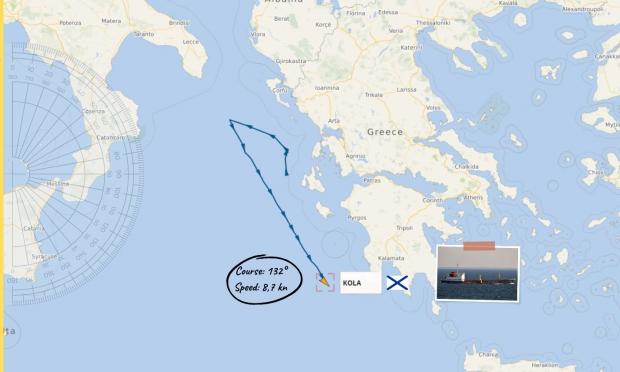NATO-Russia Cold War-type conflict and increased mobility with Russian warships and submarines in the SE Mediterranean.
The Russian Navy tanker Akademik Pashin and the frigate Admiral Kasatonov (Gorshkov) have sailed in recent days from the port of Tartu and are now sailing between southern Peloponnese and Crete.
The last satellite image was yesterday and the two units sailed south of Crete to the west.
The presence of the Akademik Pashin supply ship and the frigate Admiral Kasatonov are likely to be heading to Gibraltar where they will leave the Mediterranean to Russia.
At the same time, the Kama tanker and the frigate Admiral Gorshkov are expected to enter the Mediterranean soon (via Suez), so there will be a continuous Russian presence in the Mediterranean.
A few days ago another tanker of the Russian Navy, Kola, entered the Mediterranean via Gibraltar.
The ship is now in the Ionian Sea south of Corfu and sails north.
The presence of this ship is suspected of supplying a Russian submarine fuel sailing in the wider area off the coast of Kefalonia, performing a type of mission that has been detected in the past.
It remains to be seen whether the unit with which it is moving (a steregushchiy class corvette) will enter the Adriatic, where the Bush aircraft carrier is located or if it will remain in the northern Ionian Sea.
On the US-NATO side, they are taking their steps, sending to the Adriatic Sea, a USS George H.W. Bush, consisting of surface units and submarines.
Reports of a highly increased Russian naval activity in the Mediterranean show a picture of Russian designs for monitoring and "targeting" NATO forces in the region.
Recall that the backbone of the Russian Armada remains in the Mediterranean, in the case of any possible conflict with the United States and NATO.
If suddenly the escalation in Ukraine led to an effort to intervene in the West, then its warships could not enter the Black Sea so easily, as they would first have to face the Russian fleet and aircraft from the Tartu and Hhhimim bases.
In such a scenario, the West would have superior forces, but the price of any success for NATO would be high due to the business scale.
The purpose of the Russians, however, from their moves, is primarily to control the movements of the 6th US fleet and the ships of NATO countries in an Adriatic, the Mediterranean and the Aegean.
Greece's strategic significance for US-NATO
Greece, we realize in combination with southern Italy and Cyprus, are of particular strategic importance, since:
Otrado's strait is controlled by both the Italian coasts and Corfu.
The Sicily-Tunisian Diavos is controlled by Italy, the SE Mediterranean by Crete-Cyprus and the Aegean-Alexandroupolis-Stena of Bosporus, is controlled entirely by Greece whose islands apartment apart the archipelago in 3 sections, among the following "Greek" that are part of:
Not line: Peloponnese-Kythira-Anti-Nether-Crete (Souda) -Kasos-Karpathos-Rhodes
Middle Line: Attica-Evia-Kaa-Andros-Tinos-Mykonos-Ikaria-Samos
North Line: Halkidiki-Lemnos-Mikrician coast
In essence, no warship-submarine can enter or come out of and to the narrow direction of the Black Sea or the Aegean, without being controlled by Greece and, by extension, the US, thanks to their bases in Souda and Alexandroupolis.


